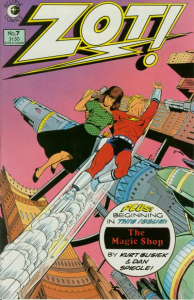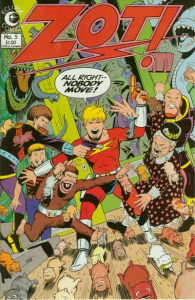A couple of months ago, I wrote about how Steve Gerber approached Superman comics from offbeat angles, articulating them with real-world issues. Today I want to spotlight a writer who chose the opposite direction – Scott McCloud’s approach to the Man of Steel was unashamedly straightforward and kid-friendly, trying to capture the material’s primordial appeal while embracing the lighter side of fantasy.
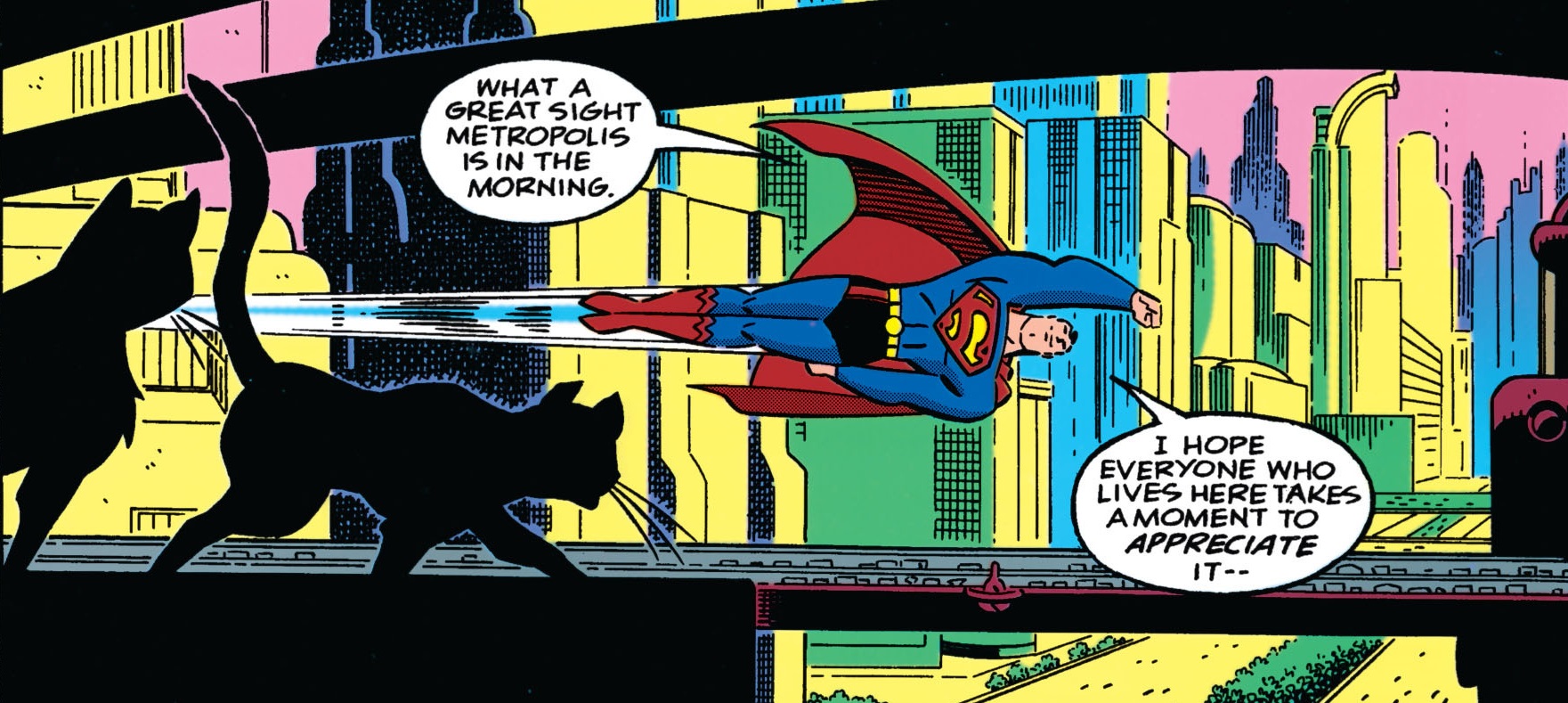 Superman Adventures #3
Superman Adventures #3
This take was particularly suited to the task at hand, since Scott McCloud’s first foray into the franchise, back in 1996-1997, involved writing the opening run of Superman Adventures. That was the spin-off comic from the excellent Superman: The Animated Series, a TV show developed by Alan Burnett and Bruce Timm which had encapsulated the greatest ideas from the Man of Steel’s various eras into one streamlined continuity.
DC had already struck gold a few years earlier when they’d hired writer Kelley Puckett to kickstart The Batman Adventures (the spin-off of the similar Batman: The Animated Series) together with artists Ty Templeton, Mike Parobeck, and Rick Burchett. This team established the comic as much more frantic and funnier than its television counterpart, emphasizing action-driven storytelling while mixing the show’s noir aesthetics with cartoony humor (the ensuing tone was not unlike Will Eisner’s The Spirit). Their run pretty much set up the style of the various subsequent Adventures books, which became the most consistent and reliably enjoyable superhero line on the stands throughout the 1990s.
I can see why DC chose Scott McCloud for Superman Adventures. His manga-inspired series Zot! had proven his desire and ability to do genre comics with a lighthearted sensibility, even at the height of the grimdark trend…
By the mid-90s, Scott McCloud had also become a well-known name in the industry, albeit mostly for his non-fiction comic book about comics, 1993’s Understanding Comics (which is mandatory reading for anyone interested in this medium).
It’s interesting to see how McCloud applied his theoretical insights about comic books to his Superman work, exploiting the medium’s language in deceptively simple ways. For instance, there is a whole chapter of Understanding Comics about how the space between panels – the ‘gutter’ – is central to the magic of comics, as that limbo is where ‘human imagination takes two separate images and transforms them into a single idea.’ The need for closure makes readers connect disparate moments, mentally constructing ‘a continuous, unified reality,’ thus constantly – and actively – participating in the storytelling process. Aware of the pleasure that can be associated with the sheer act of joining the dots and putting a puzzle together in our minds, McCloud’s Superman Adventures provided a number of fun sequences made up of sudden (yet clear) ellipses…
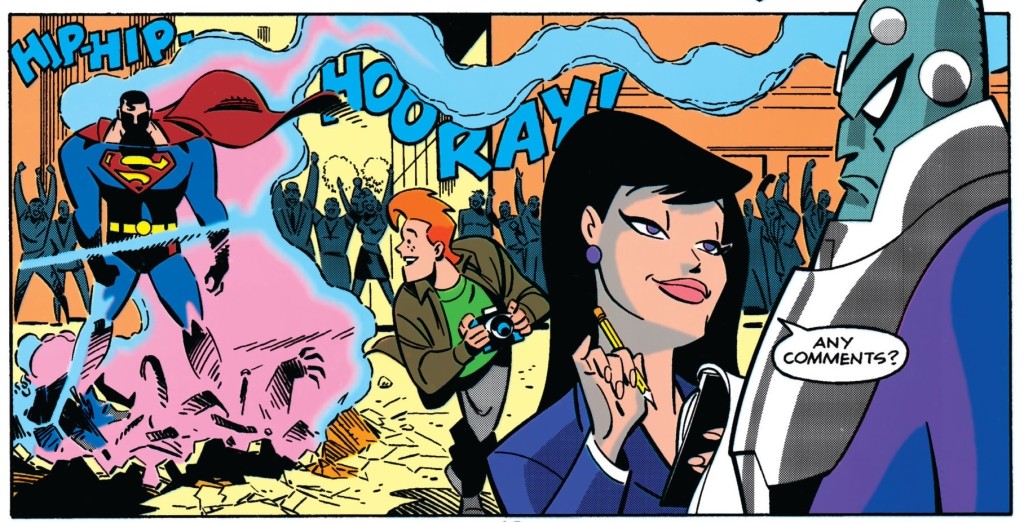
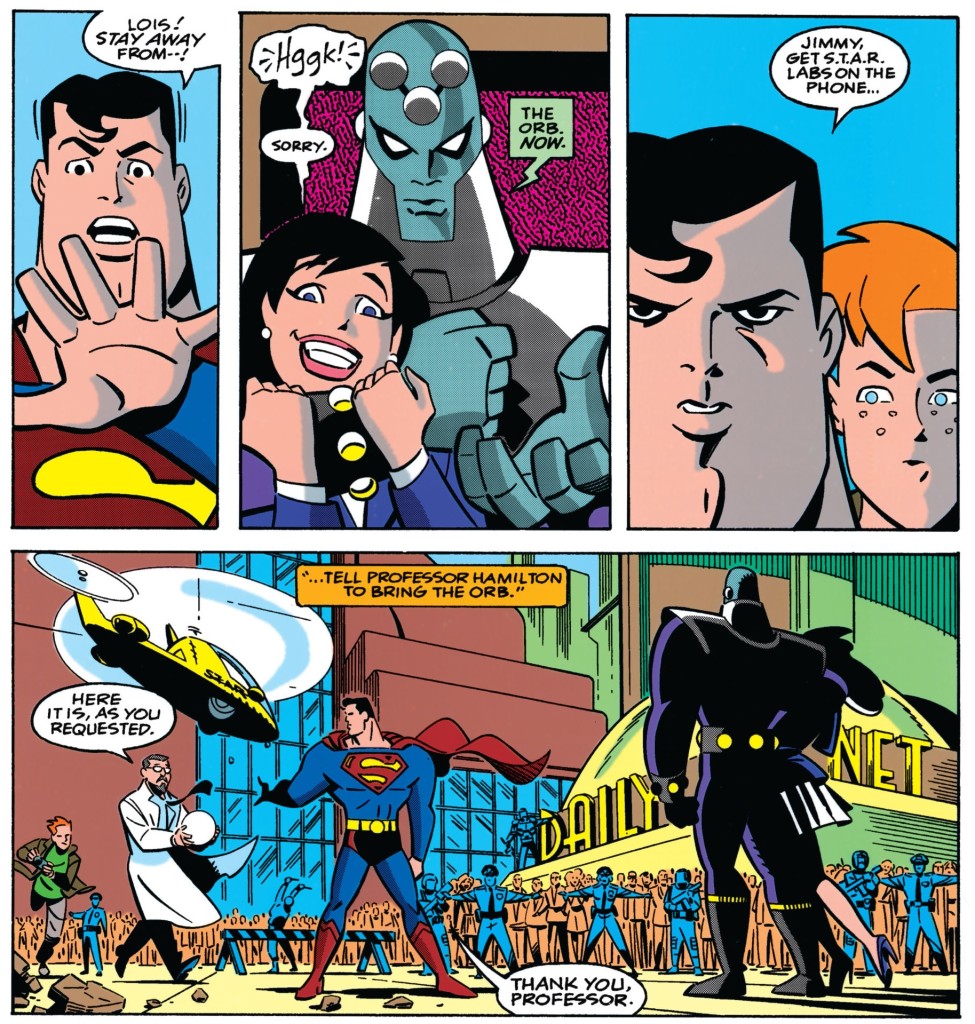 Superman Adventures #3
Superman Adventures #3
There is so much going on here – by which I mean so much that is not going on here (because it takes place in the gutter, visible only in our imagination!). The sequence works especially well in context because it comes right after a fight told mostly through what McCloud labeled action-to-action progressions, i.e. panel transitions featuring a single subject in continuous motions (in this case, Superman fighting a huge robotic cat sent by Brainiac, who was trying to steal an orb containing Krypton’s entire history). The shift to subject-to-subject transitions in this sequence not only shakes up the issue’s rhythm (preventing it from becoming monotonous), but it also causes amusement because it’s such a jarring change.
I’m not saying these comics are particularly daring and experimental. Quite the opposite: Scott McCloud wasn’t interested in reinventing the wheel here. He just put these techniques in the service of each story, using them in immersive, highly efficient ways that didn’t call attention to themselves.
It helped that McCloud was working with a team of seasoned professionals who felt quite at home with his classic – yet powerfully dynamic – narrative style. Penciller Rick Burchett and inker Terry Austin had both made careers out of action books with retro-looking designs. In the case of colorist Marie Severin, we are talking about a true veteran: she had been working in the medium as far back as 1950s’ EC Comics! They all played off each other beautifully.
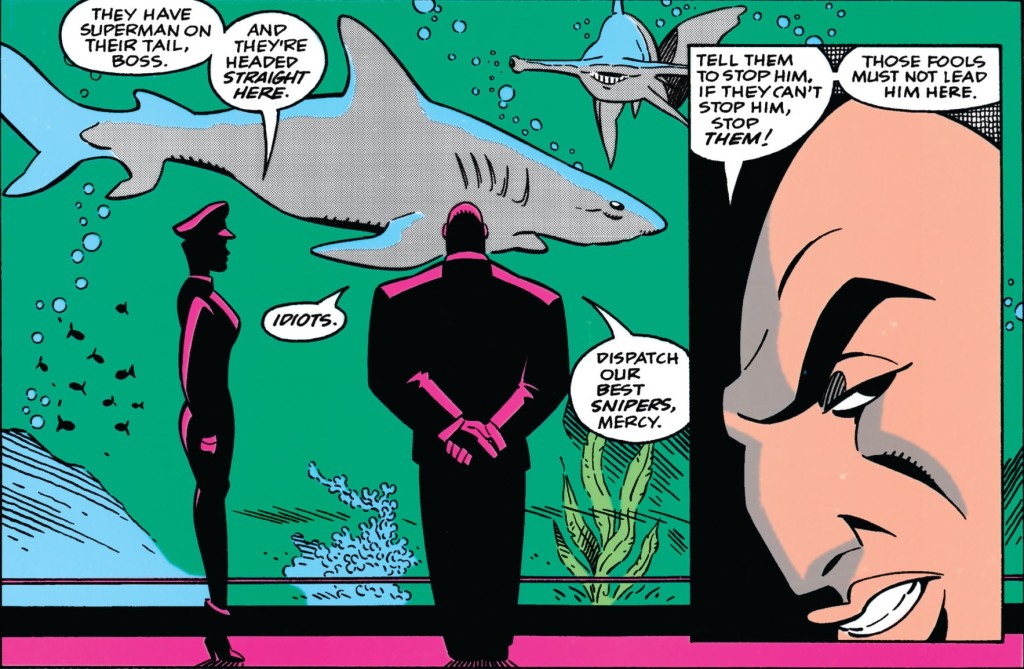 Superman Adventures #4
Superman Adventures #4
(The metaphor implicit in juxtaposing ruthless businessman Lex Luthor and a shark is pretty obvious, but I wonder who came up with the idea of making Luthor’s features so shark-like in the close-up…)
The stories and characterization followed the same spirit. Superman was a swell fella with a pure heart and everyone else stuck to familiar beats: Lois Lane was plucky, Perry White was grumpy, Lex Luthor was proud and cerebral in a sinister sort of way… All of this was in tune with the animated show, whose continuity Scott McCloud followed quite closely, doing direct sequels to some of its episodes and borrowing the TV versions of villains like Metallo, Jax-Ur, and Toyman.
The plots felt like Golden Age yarns, yet aimed at a modern (all-ages) audience, with plenty of large-scale – yet bloodless – destruction and a fair amount of lively visual comedy. With the minor exception of the corny social drama ‘Return of the Hero,’ McCloud’s 12-issue run consisted mostly of snappy, upbeat one-and-done adventures that stayed true to the traditional formula: in each issue, Superman had to overcome at least one fantastical challenge, usually by outsmarting his dangerous opponents. Thus, for example, in the clever ‘Seominod’ Mxyzptlk made the Man of Steel experience time running backwards and in the droll ‘Grand Slam’ a couple of aliens chose him to fight for Earth’s honor in the form of a bizarre intergalactic championship (a neat riff on DC’s old anthology Strange Sports Stories).
The result was generally satisfying, in a disposable type of way. The most awkward tale of the lot was ‘Balance of Power,’ in which the feminist villain Livewire censored every radio and television station in the world to remove men – a reproachable act, but is the entertainment industry’s gender balance worthy of mobilizing Superman’s greatest efforts, to the point of him asking for Lex Luthor’s help? Still, even that one had a couple of redeeming moments acknowledging the sexism built into its narrative structure (as well as in the trope of Luthor’s sexy henchwomen)…
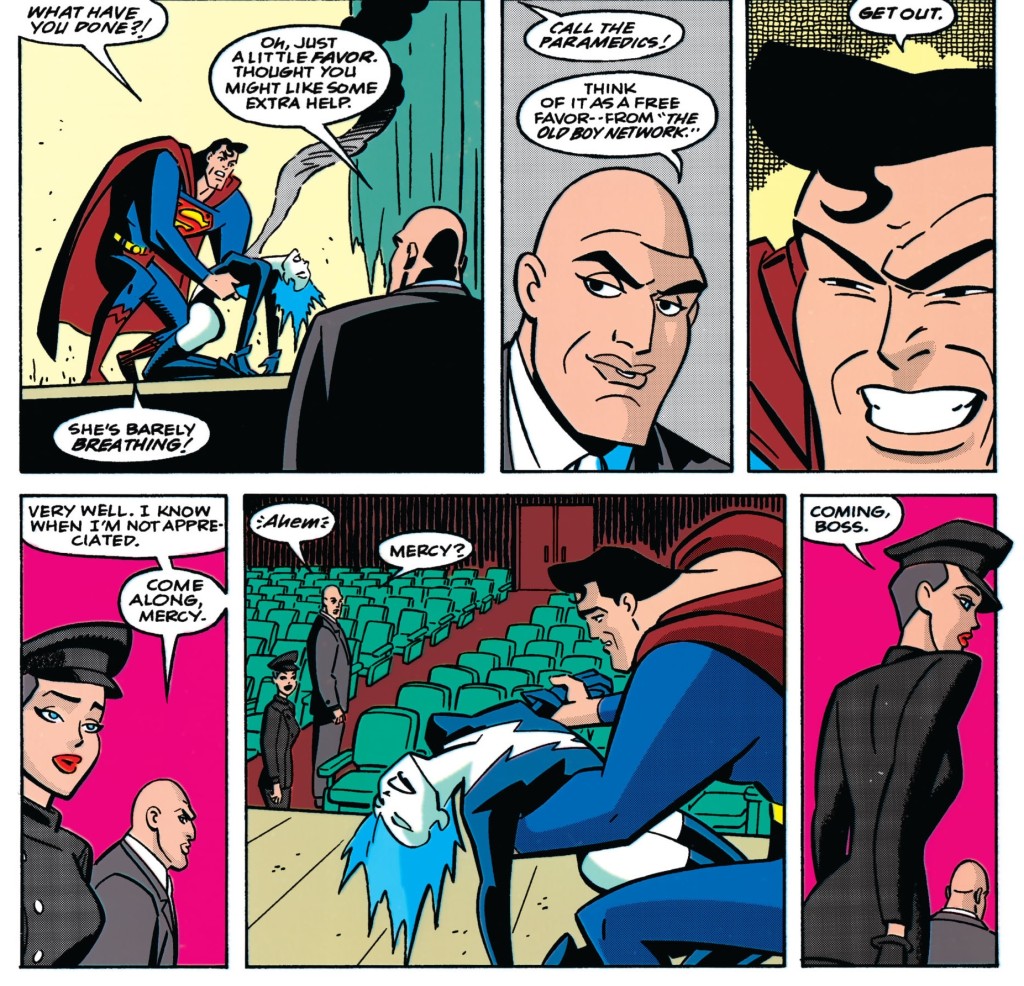 Superman Adventures #5
Superman Adventures #5
In 2003, Scott McCloud briefly returned to the Adventures universe with ‘Hide and Seek’ (Justice League Adventures #16), a very cool whodunit set in the Justice League’s satellite, although that was more of a Martian Manhunter tale, with Superman playing a relatively small role.
Two years later, we got the mini-series Superman: Strength, where the Man of Steel faced Fido, a new villain driven by daddy issues and lot of attitude. Besides writing, McCloud drew the layouts for this one, with Aluir Amancio providing the main pencils. Strength was aimed at slightly older readers, in the sense that it seemed set in the core DCU continuity (where Lois and Clark were married at the time) and Amancio’s artwork felt a bit more sexualized. Still, the comic shared Superman Adventures’ light touch and earnest take on the Man of Steel, with the main difference being that, given the higher page count (close to 150 pages for one story), Strength was much more leisurely paced. This allowed character moments to breathe more, like in this relaxing scene early on, when Pa Kent came to town…
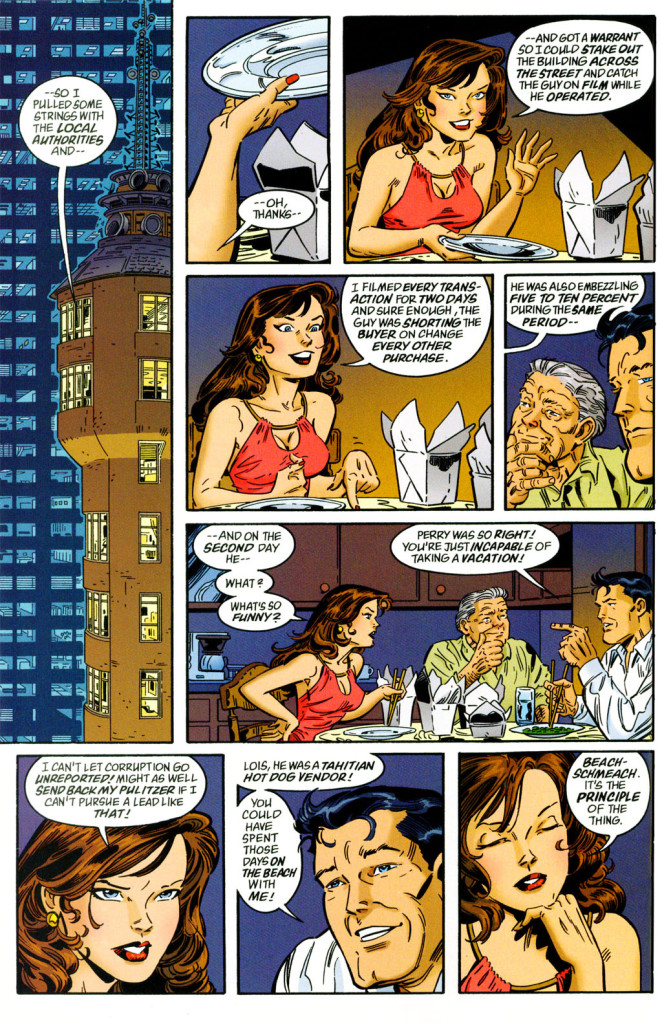
 Superman: Strength #1
Superman: Strength #1
To be fair, the decompression doesn’t always work to Strength’s advantage, as the story slogs a bit in the middle – during the schmaltzy second issue – before picking up again in the final chapter, where Superman fights giant stationery raining from the sky and chases a flying jet-car over Metropolis while Lois Lane gets shrunk and trapped in a glass container!
Thematically, this was a story about how much of Superman’s inner strength derived from his idyllic upbringing, as the Man of Steel was forced to reflect on how lucky he – and the world – had been with his own adoptive parents. You can guess a personal subtext to the whole thing (although not as much as in Scott McCloud’s acclaimed graphic novel The Sculptor). While not too explicit, the theme is there from the start, as the comic opens with Fido speculating about Superman’s happy childhood:
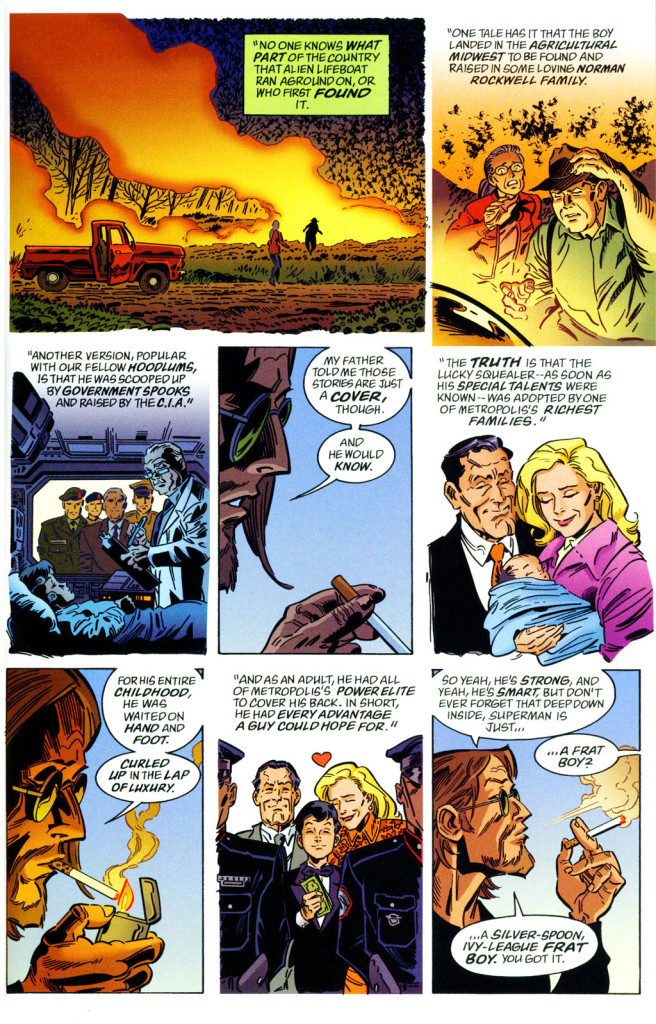 Superman: Strength #1
Superman: Strength #1
(Fido may have been wrong about the details of Superman’s origin, but, looking at the bourgeois environment of the dinner scene with Lois and Pa, there appears to be some insight to his class-based reading…)
More than anything else, it’s this thematic concern that makes Strength feel like a coda to Scott McCloud’s Superman Adventures run, in which practically every story culminated on some sort of note about heroism – either Superman’s or the brave, selfless attitude of someone around him (whether or not inspired by him). For example, the climax of the epic two-parter ‘The War Within’ involved Lois Lane in one kickass stunt after another, as she traveled and fought her way across the world in order to save Superman from Kryptonite poisoning.
My favorite ending, though, occurred in ‘Distant Thunder,’ as the Man of Steel used his super-vision to watch Krypton’s destruction, twenty-seven light years away. It’s a lovely moment that sums up McCloud’s vision of Superman as a vehicle of bright-eyed hope.
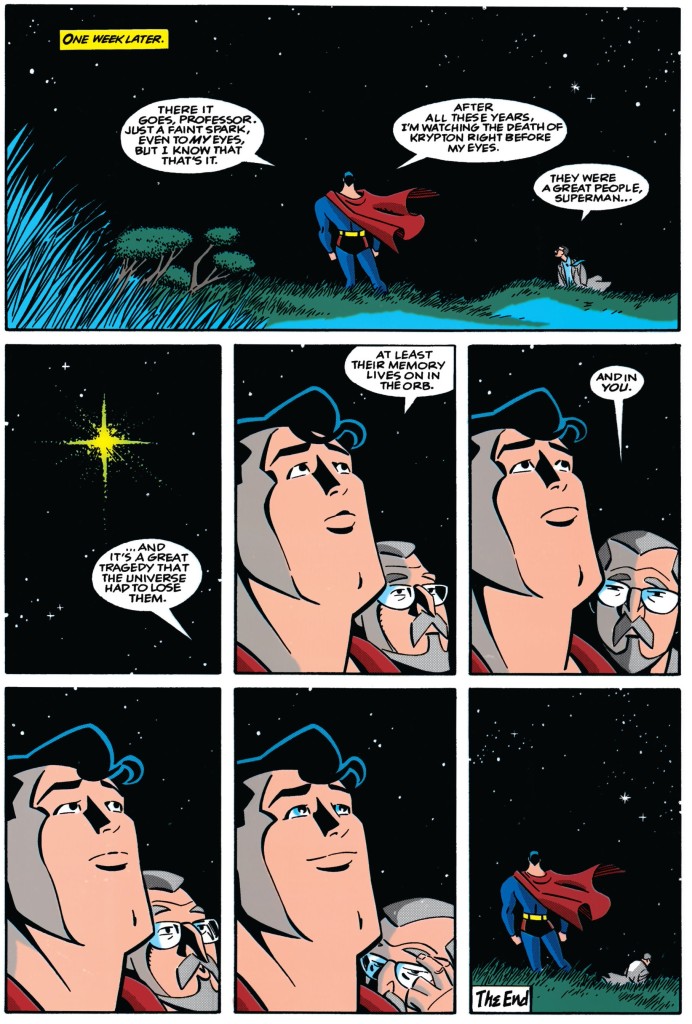 Superman Adventures #3
Superman Adventures #3
(Yes, the bright-eyed look is sold by the blue coloring of Superman’s irises in the penultimate panel, but I have no idea if McCloud scripted that or if it was an inspired choice by Marie Severin…)

